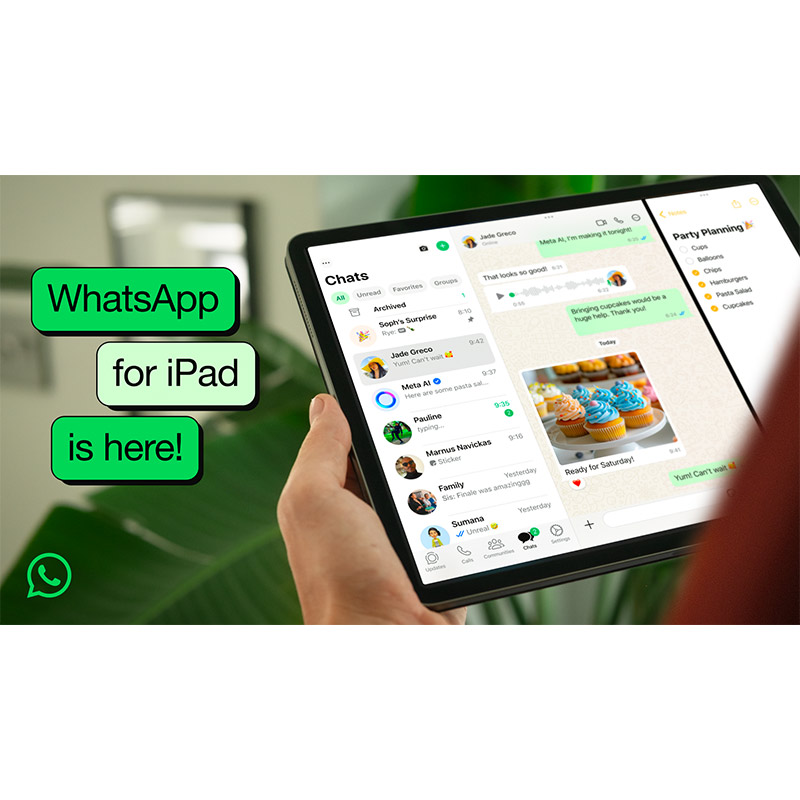
WhatsApp is already synonymous with modern communication for people around the world.
Launched in 2009 and later acquired by Meta, the app has grown to dominate the global messaging landscape, amassing over two billion active users across more than 180 countries. Its clean interface, end-to-end encryption, and seamless syncing across devices have made it the go-to platform for personal chats, business communication, and everything in between.
What truly sets WhatsApp apart is its universal appeal.
And this is further demonstrated by Meta, when it finally reveals a dedicated WhatsApp app for Apple's iPad.
In the announcement, WhatsApp said that:
"Bringing all your favorite features to a larger screen, WhatsApp for iPad makes keeping in touch with friends and family even easier. Make video and audio calls with up to 32 people, share your screen, and use both front and back cameras."
The iPad's journey began long before its official unveiling.
In the early 1990s, Apple explored tablet computing with the Newton MessagePad, a personal digital assistant that was eventually discontinued due to limited success. However, the vision persisted. In 2004, Apple initiated a tablet project codenamed "K48," which laid the groundwork for the iPad. Interestingly, this tablet concept predated the iPhone, but Apple prioritized the smartphone's development and release.
The iPad was officially introduce on January 27, 2010, and released on April 3, 2010, marking Apple's entry into the tablet market.
What this means, the iPad even predated WhatsApp.
Despite some iPad models offering cellular connectivity, they do not include a native phone dialer app. This design choice aligns with Apple's product strategy to differentiate the iPad from the iPhone.
By omitting traditional voice calling capabilities, Apple positions the iPad as a device focused on tasks like browsing, media consumption, and productivity, rather than as a smartphone replacement. This distinction encourages consumers to use both devices for their respective strengths.
And this apparently, is part of the reason why WhatsApp never really care about bothering itself developing a dedicated app for the iPad.
But this is changing.
After more than 15 years of anticipation, the native WhatsApp app for iPad marks a significant milestone for users seeking a seamless messaging experience on Apple's tablet.
Previously, iPad users had to rely on web browsers or third-party solutions to access WhatsApp, which often lacked full functionality and proper integration.
yes, it's happening https://t.co/JguqaHp2wT
— WhatsApp (@WhatsApp) May 27, 2025
Meta is now bringing WhatsApp to the iPad in a form that not only mirrors its iOS counterpart but also offers more.
Designed to take full advantage of iPadOS, the app integrates seamlessly with multitasking features such as Stage Manager, Split View, and Slide Over. This allows users to chat while browsing the web, watching videos, or working on documents—enhancing both productivity and the overall user experience.
Additionally, the app supports peripherals like the Magic Keyboard and Apple Pencil, further expanding its versatility.
As expected from WhatsApp, the app leverages multi-device technology to keep everything in sync across a user’s devices, while maintaining end-to-end encryption and offering features like chat lock for added privacy.
Following the announcement, WhatsApp's main rival, Telegram humorous replied to WhatsApp's announcement, mocking the delay in WhatsApp's iPad app release despite long-standing user demand.
Telegram introduced support for iPads in September 2014, or about a decade before WhatsApp. This update enhanced the iOS app with features such as GIF playback, cloud search, and broadcast lists, making it more compatible with the iPad's larger display and capabilities.
Initially, Telegram was launched on iOS on August 14, 2013, primarily optimized for iPhones . The subsequent 2014 update expanded its functionality to better accommodate iPad users.
— Telegram Messenger (@telegram) May 27, 2025
